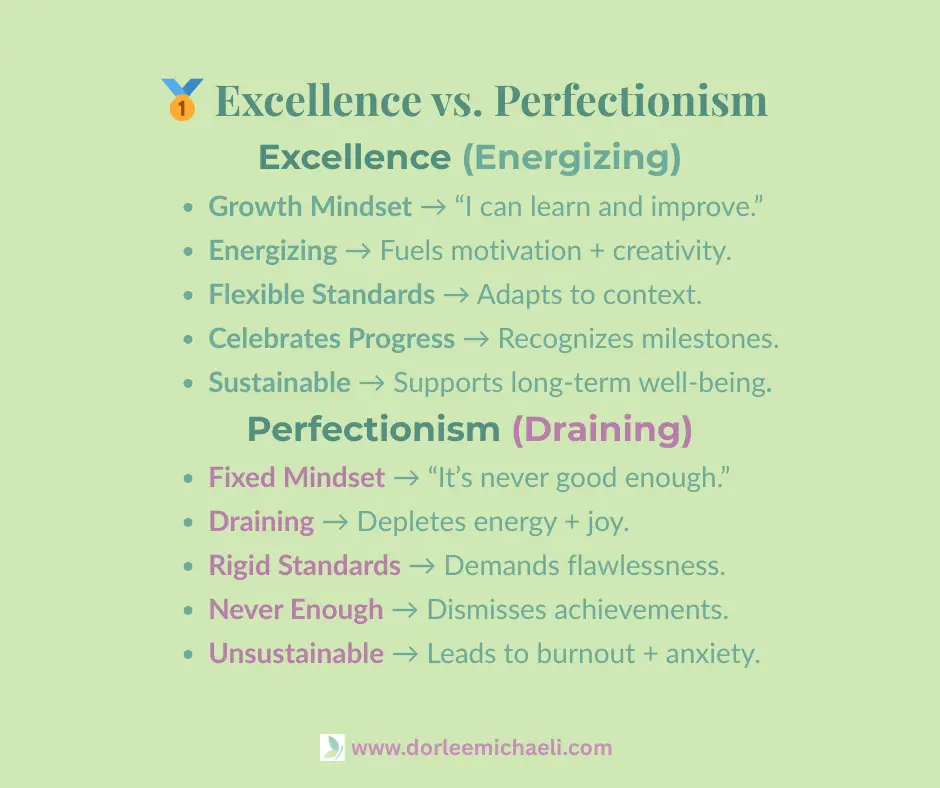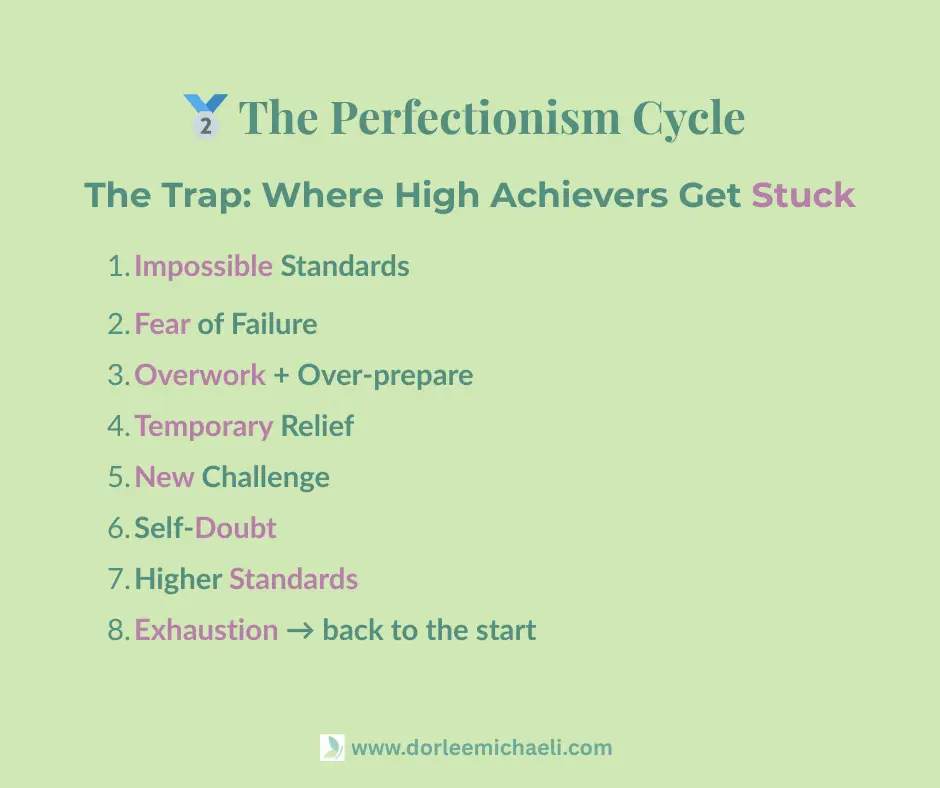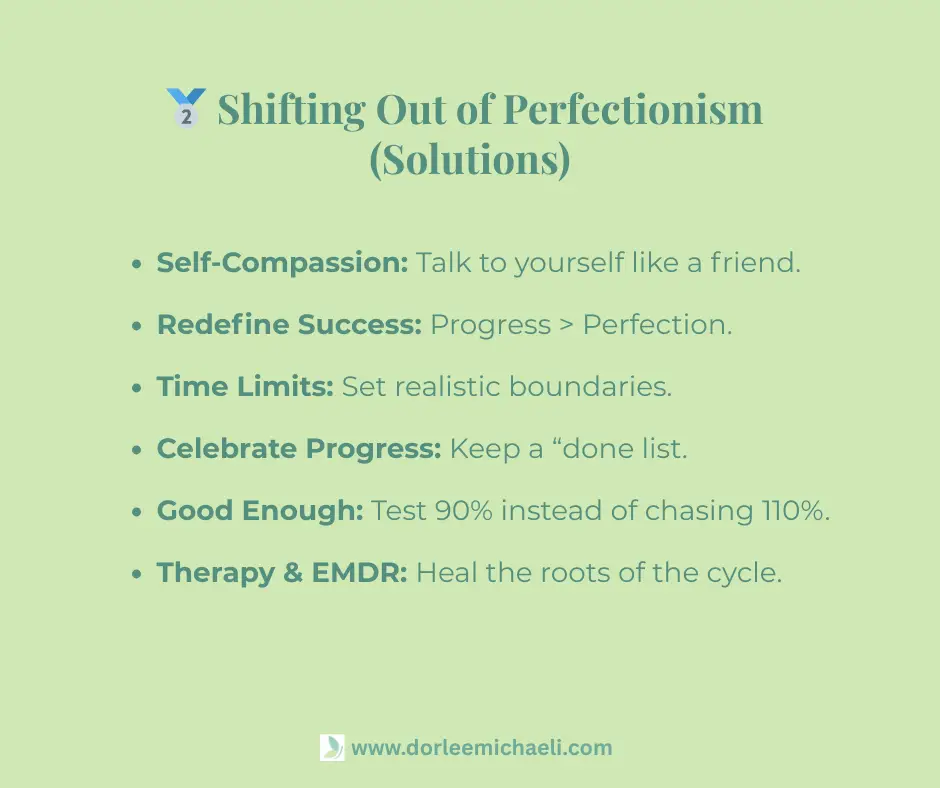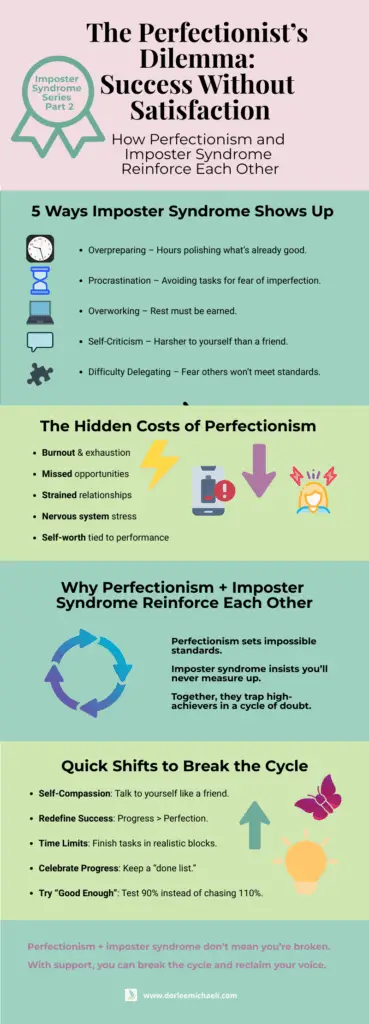
This article is Part 2 of my Imposter Syndrome Series. If you missed the first post, you can read it here: Why Smart, Competent Women Still Feel Like Frauds.
In this post, we’re looking at the Perfectionist’s Dilemma: Success Without Satisfaction, and how perfectionism and imposter syndrome often show up together as one of the most common struggles high-achievers face.
Have you felt this?
Have you ever delivered a project, only to fixate on the one small mistake instead of the dozens of things you did well?
Or stayed up late rewriting an email so every word sounded “just right”?
Or secretly thought, If I can’t do this perfectly, maybe I shouldn’t do it at all?
If so, you’ve bumped into the Perfectionist face of imposter syndrome.
For many quiet, high-achieving women, especially in fields like tech, finance, and healthcare, perfectionism doesn’t feel optional. It feels like a survival strategy.
On the surface, it can look admirable: detail-oriented, disciplined, always striving for excellence. But beneath that polished exterior lies a heavy cost: exhaustion, shame, procrastination, and the fear of being exposed as “not enough.”
A Story: Samantha’s Presentation
Samantha, a mid-level manager in finance, was asked to deliver a presentation to senior leadership. She spent weeks preparing. The night before, she was still editing her slides at 2:00 AM, worried about font consistency and whether one chart looked “messy.”
The next day, the presentation went well. Her boss praised her insights and clarity. But instead of celebrating, Samantha walked away replaying a single stumble in her delivery. By the time she got home, her main thought was: I should have done better.
Samantha’s story isn’t unusual. Many high achievers share this pattern, where accomplishments shrink and flaws expand.
Excellence Vs. Perfectionism
- Excellence is about growth, learning, and mastery. It energizes you. You can celebrate progress and take pride in your work.
- Perfectionism, by contrast, is rigid and punishing. It leaves no room for mistakes or humanity. Instead of fueling motivation, it drains because no achievement ever feels like “enough.”
Excellence says: “I’m proud of what I created, and I see where I can grow.”
Perfectionism whispers: “It’s still not good enough. And neither are you.”
Psychologists Hewitt and Flett (1991) described perfectionism as having both self-oriented (demanding perfection of oneself) and socially prescribed (believing others demand perfection of you) dimensions. Both fuel the cycle of imposter syndrome.

How the Perfectionist Pattern Shows Up
- Overpreparing – Spending hours polishing something that was already solid.
- Procrastination – Avoiding a task because doing it “perfectly” feels overwhelming.
- Overworking – Believing rest must be earned by flawless performance.
- Self-Criticism – Talking to yourself more harshly than you’d ever talk to a friend.
- Difficulty Delegating – Fearing others won’t meet your impossible standards.
These behaviors may temporarily protect against criticism, but they also keep you trapped in a cycle of stress and self-doubt.
For example:
- A physician may stay late triple-checking charts.
- An engineer may debug endlessly, long after the system is running fine.
- A manager may rewrite her team’s work, convinced clients will notice tiny flaws.
Some high achievers also struggle with the Superwoman Pattern, feeling they must handle everything perfectly without help while keeping everyone else steady.
Why Perfectionism Fuels Imposter Syndrome
At its core, perfectionism ties self-worth to performance. And when worth is conditional, it’s fragile.
Every mistake feels like proof you’re a fraud. Every success feels temporary because the next challenge looms. Instead of feeling proud of achievements, you discount them as “luck” or “not that impressive.”
This is why perfectionism and imposter syndrome reinforce each other: one sets impossible standards, the other insists you’ll never measure up.
The effects go beyond self-doubt. Research shows perfectionism is strongly linked to anxiety, depression, and burnout across settings (Egan, Wade, & Shafran, 2011). For women in high-stakes careers, the pressure intensifies, leaving them both highly capable and deeply self-doubting.

The Hidden Costs of Perfectionism
- Burnout – Constant overworking erodes joy, creativity, and even physical health.
- Missed Opportunities – Fear of imperfection may stop you from applying for jobs, sharing ideas, or seeking leadership roles.
- Strained Relationships – Expecting as much of others as you do of yourself can create tension.
- Erosion of Self-Worth – Over time, you come to believe you’re only as good as your last performance.
Left unchecked, perfectionism and imposter syndrome drain confidence, energy, and creativity, often just when women need them most for visibility and leadership. And the toll isn’t only emotional. Perfectionism also shows up in the body.
Studies show it heightens the stress response, increasing cortisol levels and disrupting sleep (Shafran, Cooper, & Fairburn, 2002). Over time, this dysregulates the nervous system, leaving you stuck in fight-or-flight mode. EMDR and other trauma-informed therapies are powerful here because they don’t just shift your thoughts; they help the body feel safe enough to let go of rigid standards.
Where Perfectionism Comes From
Perfectionism often begins as an adaptive response. Perhaps as a child you only received praise when you excelled. Or mistakes led to criticism or withdrawal of affection. Over time, being “perfect” felt like the safest way to earn love and avoid shame.
Clance and Imes (1978), in their seminal research on the imposter phenomenon, noted that many high-achieving women developed perfectionistic standards as a way to cope with internalized self-doubt.
In adulthood, especially in demanding fields, those strategies persist. But instead of protecting you, they keep you small, exhausted, and unseen.
Signs You May Be Caught in the Perfectionist Pattern
- You feel anxious or guilty taking breaks.
- You rarely celebrate wins before moving on to the next task.
- You avoid things you’re not sure you’ll excel at.
- You spend more time editing or rehearsing than the task requires.
- You often feel “behind,” no matter how much you’ve accomplished.
If these resonate, you’re not alone. And more importantly, you’re not stuck.
Shifting Out of Perfectionism
Breaking free doesn’t mean lowering your standards. It means changing how you relate to yourself.
9 Strategies That Help (with Practices)
Practice Self-Compassion
Notice the inner critic. Ask: “Would I speak this way to someone I care about?” (Neff, 2003).
Practice: Write down a recent mistake, then rewrite the story as if a close friend had shared it with you. Research shows that self-compassion reduces perfectionism and builds resilience (Neff, 2003). For more practical tools, see Self-Compassion for Perfectionists or explore Kristin Neff’s Self-Compassion Research.Redefine Success
Instead of asking, “Was it flawless?” ask, “Did this move things forward? Did I learn something?”
Practice: At the end of the week, list one project where progress mattered more than polish. Psychologists refer to this as a growth mindset shift that is rooted in the research of Carol Dweck. She illustrates how the belief in our potential to develop our abilities influences both our motivation and resilience.Set Time Limits
Give yourself a realistic boundary. When the timer goes off, the task is complete.
Practice: Send your next email after two re-reads instead of five. Research on productivity shows “time boxing” reduces procrastination and increases follow-through.Celebrate Progress
Keep a “done list” instead of only a to-do list. Mark achievements, no matter how small.
Practice: End each day by jotting down three things you accomplished, no matter how minor. This simple ritual trains your brain to notice wins, the antidote to perfectionism’s fixation on flaws.Experiment with ‘Good Enough’
Try turning in work at 90% instead of 110%. Notice how others can’t tell the difference, but you regain time and energy.
Practice: Share a draft with a colleague before you feel fully ready. Most people find their work is received more positively than their inner critic expects.Therapy & EMDR
Therapy helps identify where perfectionism and imposter syndrome took root and practice new ways of relating to yourself. By addressing both together, therapy interrupts the old cycle instead of just treating the symptoms.
EMDR (Eye Movement Desensitization and Reprocessing) helps reprocess the old experiences that keep fueling beliefs like, “I’m only safe if I’m perfect.” Many clients describe feeling lighter, freer, and more open to healthy risks after this work.
For those who prefer concentrated time to go deeper, EMDR Therapy Intensives offer a focused way to do this healing in a few powerful sessions. You can also learn more about EMDR Therapy for high achievers.
7. Seek Mentorship or Supportive Peers
Perfectionism thrives in isolation. Sharing drafts, ideas, or challenges with trusted colleagues can normalize imperfection.
Practice: Ask a peer for feedback on a work-in-progress instead of waiting until it feels “perfect.” Leadership studies show that collaborative feedback often strengthens performance and lowers anxiety.
8. Notice Nervous System Signals
Perfectionism often shows up in the body first as tight shoulders, shallow breathing, and a racing mind.
Practice: Before tackling a task, take three slow breaths, feel your feet on the ground, and remind yourself: Progress, not perfection. Trauma-informed research shows grounding practices reduce the fight-or-flight response.
9. Avoid the Trap of “Perfect Recovery”
Many high achievers try to “perfectly overcome” perfectionism, judging themselves for not letting go fast enough.
Practice: When you notice this tendency, gently say: “It’s okay. Even small shifts count.” This reminder helps you practice self- acceptance, which is the true opposite of perfectionism.

Journaling Prompts for Quiet Achievers
What would it feel like to see mistakes as stepping stones rather than failures?
When was the last time “good enough” actually turned out just fine?
What’s one area of my life where excellence (not perfection) already feels energizing?
What would I gain if I allowed myself to be visible before I felt fully ready?
FAQ: Perfectionism and Imposter Syndrome
Is perfectionism the same as having high standards? Not quite. High standards inspire growth. Perfectionism demands flawlessness and punishes mistakes.
Can perfectionism ever be healthy? Striving for excellence can be positive. Perfectionism becomes unhealthy when self-worth depends on performance.
Why is perfectionism common among women in tech, finance, and healthcare? These fields are high-stakes and male-dominated. Women often feel extra pressure to prove themselves, making perfectionism feel like protection.
How does perfectionism connect to imposter syndrome? Perfectionism sets impossible standards. When you inevitably fall short, imposter feelings intensify.
Can therapy help with perfectionism? Yes. Therapy helps uncover perfectionism’s roots, build self-compassion, and rewire unhelpful patterns. EMDR is especially effective for addressing the childhood experiences that planted these beliefs.
Why This Matters
Perfectionism doesn’t just drain energy. It keeps you invisible. When you’re stuck behind the scenes, over-preparing, you miss opportunities to lead, speak up, or shine.
Letting go of perfectionism doesn’t mean carelessness. It means reclaiming energy, confidence, and joy. It means being human, and still deeply worthy.
When you’re caught in perfectionism and imposter syndrome, success never feels safe. But with support, you can step out of the cycle and reclaim your voice, not by lowering your standards, but by relating to yourself in a new way.
This is just one of the many faces of imposter syndrome. Next in the series, we’ll explore The Soloist Pattern: Why Asking for Help Feels So Hard (and How to Shift It).
👉 For more articles in the series, visit the Imposter Syndrome archive.
For Quiet Achievers Reading This
If you recognize yourself in the Perfectionist Pattern, you’re not broken. With support, you can unlearn this old survival strategy.
If you’ve been caught between perfectionism and imposter syndrome, know that this tug-of-war isn’t a lack of strength; it’s a learned way to stay safe. Therapy, including EMDR, can help your mind and body let go of the pressure to be flawless and rebuild a calmer kind of confidence.
💜 If you’re a high-achieving woman in tech, finance, or healthcare struggling with perfectionism and imposter syndrome, therapy (including EMDR intensives) can help you step out of the cycle and into a life that feels more grounded and free.
Clance, P. R., & Imes, S. A. (1978). The imposter phenomenon in high achieving women: Dynamics and therapeutic intervention. Psychotherapy: Theory, Research & Practice, 15(3), 241–247.
Curran, T., & Hill, A. P. (2019). Perfectionism is increasing over time: A meta-analysis of birth cohort differences from 1989 to 2016. Psychological Bulletin, 145(4), 410–429.
Dweck, C. S. (2006). Mindset: The new psychology of success. Random House.
Egan, S. J., Wade, T. D., & Shafran, R. (2011). Perfectionism as a transdiagnostic process: A clinical review. Clinical Psychology Review, 31(2), 203–212.
Frost, R. O., Marten, P. A., Lahart, C. M., & Rosenblate, R. (1990). The dimensions of perfectionism. Cognitive Therapy and Research, 14(5), 449–468.
Handke, L., Klonek, F., O’Neill, T. A., & Kerschreiter, R. (2022). Unpacking the role of feedback in virtual team effectiveness. Small Group Research, 53(1), 3-39.
Hewitt, P. L., & Flett, G. L. (1991). Perfectionism in the self and social contexts: Conceptualization, assessment, and association with psychopathology. Journal of Personality and Social Psychology, 60(3), 456–470.
Neff, K. D. (2003). Self-compassion: An alternative conceptualization of a healthy attitude toward oneself. Self and Identity, 2(2), 85–101.
Shafran, R., Cooper, Z., & Fairburn, C. G. (2002). Clinical perfectionism: A cognitive–behavioural analysis. Behaviour Research and Therapy, 40(7), 773–791.
Stoeber, J., & Otto, K. (2006). Positive conceptions of perfectionism: Approaches, evidence, challenges. Personality and Social Psychology Review, 10(4), 295–319.
Zao-Sanders, M. (2018). How timeboxing works and why it will make you more productive. Harvard Business Review. Retrieved from https://hbr.org/2018/12/how-timeboxing-works-and-why-it-will-make-you-more-productive
Published: September 17, 2025, Last updated: Nov 30, 2025





This really hit home. I’ve lost count of how many times I’ve stayed up late tweaking something that was already ‘good enough,’ only to feel drained instead of proud afterward. I love how you distinguished excellence from perfectionism. Excellence feels expansive, but perfectionism just shrinks everything down to self-doubt. Such a powerful reminder that progress is worth celebrating.
I really appreciate you sharing this, Cheryl. What you described, pouring hours into something already ‘good enough’ only to end up exhausted, is such a common perfectionist loop. I know that feeling myself, and I’ve seen how often it leaves people drained instead of proud. I love how you put it: excellence feels expansive, while perfectionism shrinks us down. That’s such a clear way of capturing the difference. And yes, celebrating progress (instead of chasing flawless) can feel like such a relief.
Wow – another robust article, Dorlee!
2 key takeaways (out of about a dozen!), for me:
1. The idea of redefinining success by asking, “Did this move things forward? Did I learn something?” <- Brilliant!
2. Time boxing. This one particularly resonates because about 12+ years ago, I downloaded a 'time tracking' app that is so easy peasy, and I track my projects/tasks. Often, while writing a career story, I'll further supplement this with my phone timer to 'time-box' 45 minute writing windows to complete certain components of the career story. This keeps me from obsessing over every word or phrase and instead advancing through phases of the resume story with the reward of mini-breaks to stretch my legs; pop in a load of laundry; network on social media; etc.
Thanks again, Dorlee, for your thoughtful and applicable to real work and life insights!
Jacqui
Thank you, Jacqui, for highlighting those two takeaways! Redefining success in terms of learning and moving forward has been so helpful for me too; it takes the pressure off ‘perfect’ and lets the process feel more doable. And I love how you’ve already built time-boxing into your writing process. Pairing it with movement and small breaks is such a healthy, sustainable approach. I’ve found that kind of structure can really keep perfectionism in check. Grateful for you sharing your practical example here. I know it will inspire other readers.
What a great piece. I love how you highlight the difference between excellence and perfectionism, and how clearly you connect perfectionist symptoms to imposter syndrome. Such a thorough article with real insight, practical solutions, and a great list of references for further reading.”
Thanks so much for this thoughtful feedback, Heather. I’m really glad the distinction between excellence and perfectionism resonated. It’s such a subtle but important shift. And I appreciate you noticing the references and solutions; I wanted the piece to feel both practical and research-grounded.